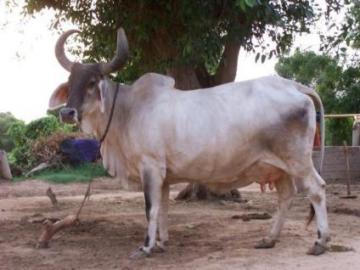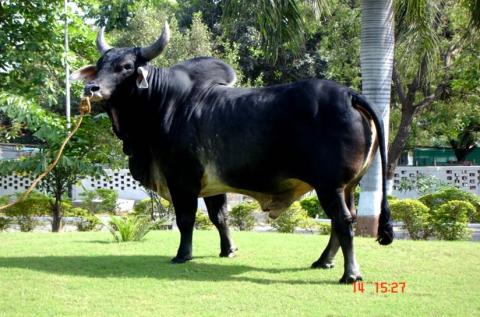
Kankrej cattle are also known as “Wadad” or “Waged”, “Vagadia”, “Talabda”, “Nagar”, “Bonnai”. It takes its name from the name of geographical area i.e. Kankrej taluka of Banaskantha district in Gujarat. They are found in the area southeast of Rann of Kutch comprising Mehsana, Kutchchh, Ahmedabad, Kheda, Anand, Sabarakantha and Banaskantha districts of Gujarat and Barmer and Jodhpur districts of Rajasthan. Kankrej, famously known as Guzerat in Brazil, is being maintained in large numbers as a pure breed in that country. The Guzerat was the most important breed in the formation of American Brahman. The unique characteristics like resistant to tick fever, heat stress, very little incidence of contagious abortion and tuberculosis made Kankrej a very popular one among these countries. Coat colour of the animal varies from silver grey to iron grey and steel black. In males, forequarters, hindquarters, and hump are slightly darker than the rest of the body. Bulls tend to get darker than cows and bullocks. The hump in the males is well developed and not as firm as in other breeds. Forehead is broad and slightly dished in the centre. Face is short and nose slightly upturned. Unique characteristic of this breed is its large, pendulous ears. The horns are lyre shaped. The cows are good milkers and bullocks are used for agricultural operations and road transport. The cows yield on an average 1738 kilo grams and a maximum of 1800 Kg of milk in a lactation. Selected cows have produced around 4900 Kg at village conditions.
For further details please see the following link
http://14.139.252.116/agris/breed.aspx
Compiled by Animal Breeding Group, NDDB from Information System on Animal Genetic Resources of India (AGRI-IS)- developed at National Bureau of Animal genetic Resources, Karnal, Hariana, India. (However, As per bifurcation of states/ districts- revisions have been made)

